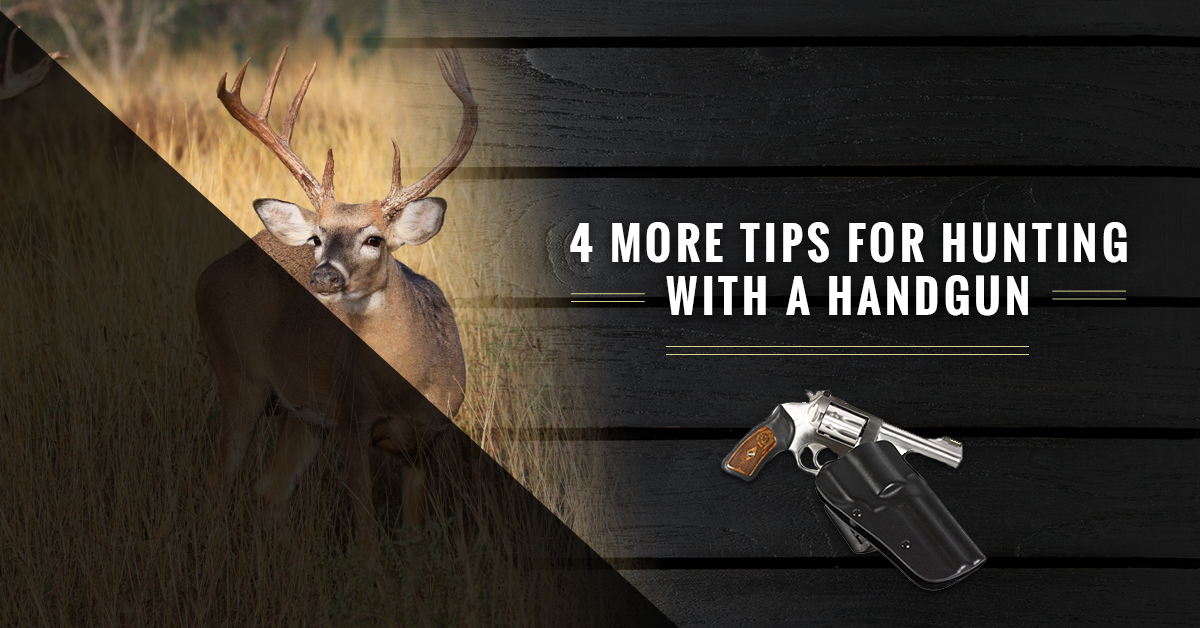Without a doubt, handgun hunting can be seen as an extension of hunting as a whole. But there are so many difference between it and traditional rifle hunting that it requires a few extra tips that you should consider before you grab your high-powered handgun and head out to your favorite hunting spot.
What you’ll find below aren’t the only important tips. In our previous blog we discussed some tips on how to improve your handgun hunting skills. First of all, it’s important to know your prey, especially how close you can get to them; deer can be hunted with .357 Magnums, but larger game are going to need .454. Casull or .460 S&W Magnum because of both size and how close you can get to them. We also discussed why you need to get to know your firearm so that you can get as steady a bead as possible with the proper grip and trigger pull. It’s also important to calm yourself with proper breathing techniques so that you know when to pull the trigger.
But that’s not all you need to know. Here are a few more tips on how you can become a better handgun hunter if rifle hunting has become a bit too easy for you.
Build Up Your Strength and Endurance
If you’ve ever worked out with weights, you know that a weight held closer to your chest feels a lot less heavy than one held at arm’s length. This doesn’t make much of a difference when you’re holding your one-pound Ruger 5-shot 9mm, but things change when the gun gets heavier. A lot heavier.
So while walking around with your five-pound handgun in your revolver holster might not be a big deal, holding it out three feet in front of you means that you’re dealing with a higher torque. The farther you hold something out, the more force it takes to lift it up. So if you plan on shooting without a monopod or tripod, you might want to work out with weights (or practice holding the unloaded handgun at arm’s length a lot).
Don’t Overdo the Scope
When most people walk into a sporting good store looking for a pair of binoculars, many will think that the 10X or 12X are better than the 8X. After all, a more powerful pair will get you closer to the action, right? What they aren’t thinking about is the shake, because the closer something focuses, the more pronounced the shake is (and everyone’s hands shake to some degree). It’s the same with handgun hunting scopes, because the “closer” you get to something the more wobble there will be.
Not only that, but you also have to worry about finding the target in the first place. Simply finding the target in the scope can be difficult if your scope is too powerful. That’s just one more reason to know your prey and how close you’ll be able to get to it, because being too close with a scope that’s too powerful means the scope might become useless.
Will You Stand? Will You Sit?
When you’re hunting, there’s not usually a chest-high wall that you can stand behind to prevent the animals from seeing you. You might have some vertical cover in the form of trees, but not every environment is going to provide you cover when you’re standing. If the only cover on the plains are three-foot-high brush, you’d better learn how to shoot sitting down.
Of course, that means practicing your shooting while sitting. Shooting with a handgun from a sitting position isn’t something that most shooters are familiar with, apart from maybe plinking with that LCR we mentioned and a bucketful of 9mm moon clips from a lawn chair. You’ll want to find the sitting position that works for you, and find one that allows you to be comfortable while still maintaining your accuracy. After all, being uncomfortable is one way to ensure you miss the shot.
And since you’ll be sitting, you’ll need to…
Practice With The Gear
Setting up a hunting tripod in the garage or at the gun shop is easy. Doing so in the field, where there is brush getting in the way, is a lot tougher. Not only that, but in the garage you don’t have to worry about being quiet. In the field, the prey can easily be alerted by pod legs being moved into position.
You’ll want to practice with your gear in the field before the hunt. Draw your handgun from the revolver holster while you’re in the brush, find out how to set up the tripod as silently as possible, and make sure you watch out for your scope so that it doesn’t snag. It’s also important to work with your protective equipment. While you might be wearing your eye and hand protection all day, it’s important to get good at slowly and silently accessing your ear protection and putting in your earplugs and earmuffs.
Once many hunters discover the thrill of stalking their prey and getting up closer to it, they simply don’t want to go back to rifle hunting. Make no doubt about it, handgun hunting takes a lot of skill and practice (.44 Magnum speedloaders help with that practice, if that’s your firearm of choice), but once you start it’s hard to stop. If you think it’s for you, get your gear and start practicing!


